Ryan Hall's Blog, page 297
January 25, 2016
Boston-Bound: Tailor Your Marathon Training For The Next 12 Weeks
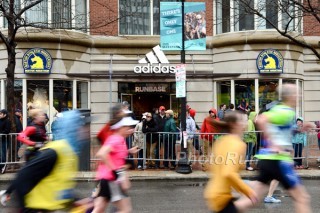
Photo: PhotoRun.net
Training for the Boston Marathon is unlike getting ready for any other marathon. It’s all about getting ready for the Boston Marathon and the unique challenges and opportunities this race presents. Done correctly, you can run very well in Boston; done incorrectly, and the course will eat you alive.
It’s important to understand who this training is for and who it’s not. First, this is for athletes who have qualified for (and are running) Boston. By default, this means that this marathon is, at minimum, your second marathon (but often your third, fourth, fifth, etc.) so what you will see is not designed for a first-time marathoner.
Second, runners training for Boston shouldn’t be starting from scratch. You’ve recovered from your previous training cycle, built back a solid aerobic base (consistent weekly mileage and long runs) and are ready for 12 weeks of focused training. You are not injured and can easily run for 45-60 minutes on mid-week runs and 90-105 minutes on long runs. In other words, you’re ready to begin marathon training, not just begin training.
Training: Weeks 1 & 2
With three months to go until race day, our focus right now is on developing VO2max, leg turnover, leg strength and mental toughness. This is slightly different than many training plans that work on stamina first and speed second (or work on both at the same time across the plan).
I learned long ago that for the vast majority of marathoners—especially Boston marathoners—it’s better to first fatigue the runner with the speed of workouts (first few workouts) and, as the marathon approaches, fatigue them with the duration of workouts. This philosophy puts the most race-specific training closest to the race, something that is in accord with basic training theory.
Early in the training, I want you to be mentally challenged with workouts that elicit the same kind of suffering you get in a 5K. I want you to get used to high levels of suffering for a short amount of time. What I’ve found is that this allows you to better tolerate the lower level (but longer lasting) suffering that the upcoming marathon-specific workouts (and race) produce.
Coach’s Note: I’m going to present the key workouts and long runs for each week of training. Each reader will be different in the number of runs she does each week so I’ll let you fill in the other easy runs, cross-training and off days based on your usual running schedule.
Week 1
Twelve weeks out from the race, I suggest a hill workout and a long run. For advanced runners accustomed to doing two workouts and a long run during each week, I suggest also adding a progression run.
Workout #1: Hill Repeats. Warm up 15-30 minutes of easy jogging, then run 6 to 10 times a moderately sloped hill (6-8 percent grade) at 5K effort or harder lasting 60 to 75 seconds. Jog back down the hill for recovery between repeats, then cool down with 15-30 minutes of easy jogging.
Workout #2 (advanced runners): Progression Run. Easy run for 60-80 minutes with the last 10-20 minutes at a slightly faster pace (around tempo effort).
Long Run: 1:45 – 2:00 (which will be 12-16 miles for intermediate runners and 14-20 miles for advanced runners, respectively). If you can complete the run without fuel, great. If you need to fuel, only fuel enough to complete the run but try to use as little as possible. Our goal is to expand the muscles’ store of carbohydrates (called glycogen) and a good way to do it is to deplete the stores in these long runs, which then stimulates the body to store more glycogen afterward. So, we want to minimize external fueling so we use more of these internal fuels and thus stimulate more fuel storage.
Week 2
With 11 weeks to go, we continue to work on VO2max, leg turnover, leg strength and mental toughness. Note that I’m suggesting effort-based VO2max training (a.k.a fartlek runs) as opposed to the usual track workouts to build VO2max. I do this because I prefer these workouts are performed over a hilly route where the runner will do some fast running uphill, some fast running downhill and some fast running on the flats. The pace will vary depending on the terrain, so effort is a good way to monitor the workouts. By following this approach, we are beginning the process of getting used to the Boston course.
Workout #1: Fartlek Run. Warm up with 15-30 minutes of easy jogging, then alternate 8 to 12 times one minute at 5K effort (or harder) with one minute at an easy pace for recovery. Cool down with 15-30 minutes of easy jogging.
Alternative Workout: For runners who are what I call Endurance Monsters (perform much better at long races/workouts and find that speed training causes undue mental and physical fatigue), I have them warm up then run at Steady State pace (easy-medium effort) for 4-6 miles, then cool down. Note: You can calculate your exact Steady State Pace on my McMillan Running Calculator.
Workout #2 (Advanced runners): Leg Speed. Warm up with 15-30 minutes of easy jogging, then alternate 8 to 12 times 20 seconds at faster than 5K pace with one minute at an easy pace for recovery. Then cool down with 15-30 minutes of easy jogging. Note: This leg speed workout is best done on flat terrain.
Long Run: 2:00-2:30 for sub-3 hour marathoners; 2:00-3:00 for 3+ hour marathoners
The post Boston-Bound: Tailor Your Marathon Training For The Next 12 Weeks appeared first on Competitor.com.
Photos: 2016 Miami Marathon and Half Marathon
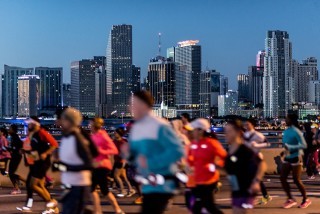
The Miami Marathon and Half Marathon took place Sunday in some cold temperatures—relatively speaking, of course.
While much of the east coast was buried in snow, runners in Miami started the race in 46-degree weather, a record low for the 14th annual race.
The men’s marathon winner was Benazzouz Slimani of Morocco, who won in 2:24:56 just two days after turning 40. The women’s winner was Allison Kieffer, a New Yorker who signed up for the race as a winter getaway but entered the elite field the day before the race for a chance at more prize money, according to the Miami Herald. She finished in 2:55:31.
Stephen Njoroge of Kenya won the men’s half marathon in 1:05:08, while Santa Ines Melchor Surquillo of Peru won the women’s half in 1:13:52.
Here are photos of the race, courtesy of the Miami Marathon and taken by Roberto Ojeda:
Photo Gallery
1 of {count}
Back to Start
View Larger Image

View Larger Image

View Larger Image

View Larger Image

View Larger Image

View Larger Image

View Larger Image

View Larger Image

View Larger Image

View Larger Image

View Larger Image

View Larger Image
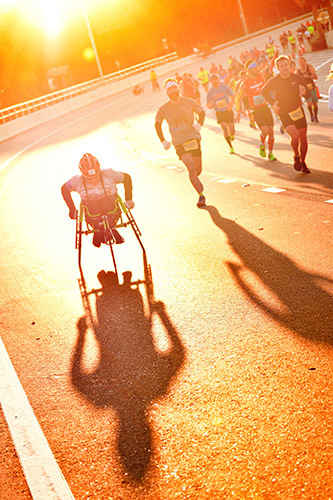
View Larger Image

View Larger Image

View Larger Image

View Larger Image

View Larger Image

View Larger Image

View Larger Image

View Larger Image

View Larger Image

View Larger Image

View Larger Image

Related Galleries

Photos: 2016 Carlsbad Marathon and Half

Photos: 2016 Houston Marathon and Half Marathon

Photos: 2015 Brazos Bend 100

Photos: 2015 Honolulu Marathon

More Galleries
The post Photos: 2016 Miami Marathon and Half Marathon appeared first on Competitor.com.
January 22, 2016
Video: Katie Rainsberger Surprised as Gatorade Cross Country Runner of the Year

Katie Rainsberger, the NXN national champion out of Air Academy High in Colorado Springs, was surprised at school on Thursday and named Gatorade National Cross Country Runner of the Year in a ceremony. Rainsberger, the daughter of 1985 Boston Marathon champion Lisa Rainsberger, dominated the competition during her senior year and will attend Oregon this fall.
The post Video: Katie Rainsberger Surprised as Gatorade Cross Country Runner of the Year appeared first on Competitor.com.
19 Wild and Wacky Fun Runs
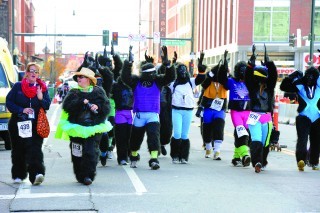
Gorilla Run, Photo: Hans Bucher, Courtesy of Gorilla Run
Let’s face it, sometimes even the most ardent runner needs to shake up the routine a little bit. A little variety never hurt anyone—in fact it’s a chance to experience something entirely new. We searched high and low for the nation’s most peculiar yet challenging fun runs. Here’s your chance to get off the beaten path in 2016.
The Empire State Building Run-Up
Feb. 3, New York City
Though you are only running less than a quarter-mile in this unique vertical sprint, your heart will be pounding and your lungs screaming by the end of it. That’s because you’ll be on top of the Empire State Building—a mere 1,576 steps, or 88 flights of stairs from the street-level starting line.
Krispy Kreme Challenge
Feb. 6, Raleigh, N.C.
What began among 10 friends over a decade ago now boasts more than 8,000 runners who run 2.5 miles from North Carolina State University into downtown Raleigh for a dozen glazed donuts from Krispy Kreme. Luckily you get to run another 2.5 miles back trying to keep them down.
Cupid’s Undie Run
Feb. 13–14, multiple locations
Every Valentine’s Day weekend, thousands of runners across the country strip down to their skivvies and run a mile to help raise money to fight neurofibromatosis, a rare children’s genetic disorder that occurs in 1 in every 3,000 births. The more you raise, the better the swag earned—post-race open bar, exclusive undies and socks and a stylin’ robe are but a few choice items.
MJJA Cave Run and Polar Plunge
Feb. 20, Crystal City, Mo.
Become an underground dweller for a morning of high-speed spelunking as you navigate a 3-mile course that weaves in and out of corridors and caverns. Held inside an old sand mine, runners must deal with mushy sand underfoot, several streams to ford and large dunes to climb. Remember to bring your headlamp!
Twinkie Run
April 1, Ann Arbor, Mich.
What better way to celebrate April Fool’s Day than by running a 5K and indulging in one of America’s unhealthiest foods: the Twinkie. There are two fueling locations where you can partake of the sponge cake. Held annually to raise money for the fight against ALS, this high-caloric race is for a worthy cause.
Caliente Bare Dare 5K
May 1, Land O’Lakes, Fla.
When you are going to be running naked around one of the more upscale clothing-optional resorts in America, you want to look your best. Runners will make one loop within the grounds while similarly non-attired spectators cheer you on. But don’t be fooled: This race is USATF certified and determines the National Championship of Nude Running, so there is a talented field.
Camp Pendleton World Famous Mud Run
June 5–6, San Diego
If you’re looking for one of the tougher mud runs on the planet, look no further than this one. Hosted by the U.S. Marine Corps since the early 1990s, participants endure a 10K with more than 20 obstacles, including several combat-related features that offer a hint of what USMC basic training is all about, such as the 100-foot mud pit at the end that will coat you top to bottom.
Boom Days Pack Burro Race
Aug. 7, Leadville, Colo.
Held every August for the past 68 years to honor Leadville’s mining past, this race requires two participants per team—a human and a donkey. The burro must carry a packsaddle loaded with prospecting gear, while the human needs to have a deep reservoir of patience to navigate his or her burro along a mountainous 22-mile course to the top of 13,300-foot Mosquito Pass and back.
Minnesota Monster Dash Half Marathon, 10 Mile and 5K
Oct. 26, Minneapolis-St. Paul
What better way to wrap up your fall running season than taking to the streets with several thousand other runners all dressed up in their Halloween costumes. The best part of this race is the entire course is downhill and offers you the perfect chance to set a PR.
The Gorilla Run
Nov. 13, Denver
For the past 12 years, hundreds of people have dressed up in gorilla suits or banana costumes and taken to the streets for this 5K to raise money for the Mountain Gorilla Conservation Fund. For $100, racers get their own suit, which they can keep, and entry into the Silverback After Run party. The race itself is held on a flat, out-and-back course.
Runyon 5K
Nov. 15, New York City
This 5K is held entirely inside the hallowed halls of Yankee Stadium. Runners start at the ground floor of the stadium and wind throughout the bowels of the stadium before climbing ramps and stairs to the higher concourses ringing the field. Although you don’t get to step foot on the actual field, you do get to take two laps on the warning track encircling it.
NYRR Midnight Run
Dec. 31, New York City
Normally the idea of going for a midnight run in Central Park would appeal to very few—how many movies have featured good things happening in the park at night? However, this annual race is different. The gun sounds exactly at midnight when the fireworks light the sky after the golden globe has descended in Times Square, cueing more than 6,000 racers to embark upon a 4-mile trek through the park.
The post 19 Wild and Wacky Fun Runs appeared first on Competitor.com.
25 Iconic American Road Races
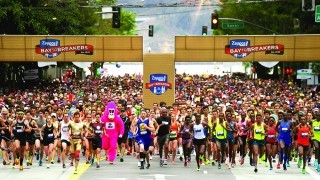
Bay to Breakers (Photo: Zappos.com Bay to Breakers)
Whether you’re a 5K or 10K junkie, or just want to try a different race distance, there are famous events all over the U.S. that put on an amazing race year after year. Here are 25 of the best across America.
Great Aloha Run
Feb. 15, Honolulu
More than 20,000 runners and walkers take on this 8.15-mile course that starts in downtown Honolulu and finishes at Aloha Stadium. The race kicks off with the “Sounds of Freedom,” in which thousands of military members run the course in formation before the civilians get started.
World’s Best 10K
Feb. 28, San Juan, Puerto Rico
With 15,000 runners taking to the streets of San Juan, this 10K is Puerto Rico’s biggest sports-tourism event. It’s popular among elite runners, owing to both the large prize purse and the late-February running. Plus, it has awesome scenery: The course revolves around the 1.4-mile Teodoro Moscoso Bridge.
Crescent City Classic
March 26, New Orleans
Taking place Easter weekend, everything we love about New Orleans—the Superdome, the French Quarter, City Park—is on display for the more than 20,000 runners who participate in this 10K each year. The race debuted in 1979.
Marine Corps 17.75K
April 2, Dumfries, Va.
The unique race distance commemorates the birth year of the U.S. Marine Corps (it’s roughly 11.03 miles). The race is near Marine Corps Base Quantico, and participants over age 14 get guaranteed access to the popular Marine Corps Marathon in October.
Cooper River Bridge Run
April 2, Mount Pleasant, S.C.
Centered around the 2.5-mile Arthur Ravenel Jr. Bridge connecting Mount Pleasant to Charleston, this 10K is a point-to-point run that started in 1978 and is now one of the biggest 10Ks in the world. The race is capped at 40,000 entrants, and the winners get a $10,000 prize plus potential bonuses.
Carlsbad 5000
April 3, Carlsbad, Calif.
The springtime 5K runs mostly along the Southern California coastline overlooking the vast Pacific Ocean just north of San Diego. It is known for being fast due to its flat course and the elite runners who participate every year.
Shamrock Shuffle 8K
April 3, Chicago
Starting and finishing in Chicago’s famous Grant Park, this spring-themed 8K takes 40,000 runners on a tour of the Windy City. Parts of the course share the same stretches as the Chicago Marathon course in October.
B.A.A. 5K
April 16, Boston
If you want to race in the center of the running universe (but aren’t quite Boston Marathon-qualifying fast), the B.A.A. 5K is a great race that takes place Boston Marathon weekend. The race starts and finishes in Boston Common and passes the Boston Marathon finish line, Newbury Street and the Public Garden.
Lilac Bloomsday Run
May 1, Spokane, Wash.
This 12K offers runners a great race for a low entry fee in a beautiful location. The race, founded by running great and past Olympic marathoner Don Kardong, has 92 runners who have finished every single year since it started in 1977.
Healthy Kidney 10K
May 14, New York City
This race takes place entirely on the famous Central Park loop, a route on every runner’s bucket list. The prize purse for elites is one of the largest for a 10K in the U.S. ($25,000 for the winner in 2014).
Bay to Breakers
May 15, San Francisco
One of the wildest races you’ll ever sign up for, this 12K has taken on a life of its own. Every year runners dress up in their boldest, brightest and quirkiest costumes, and run 7.46 miles from the San Francisco Bay (just a few blocks from the Embarcadero) to the Great Highway where breakers crash onto Ocean Beach.
Navy’s Bay Bridge Run
May 15, San Diego
This 4-mile race offers one of the only chances to run across the iconic Coronado Bay Bridge, a 2.1-mile bridge that stands 200 feet above San Diego Bay and presents spectacular views of downtown San Diego and nearby Coronado.
Bolder Boulder
May 30, Boulder, Colo.
A Memorial Day tradition since 1979, this 10K winds through one of the top endurance-sports towns in the world. It provides mile-by-mile splits for each runner. It has a great elite field leading the way. Runners cross the finish line at Folsom Field, Colorado University’s football stadium, with 50,000 fans cheering you on.
Freihofer’s Run for Women
June 4, Albany, N.Y.
This is an all-female road race that’s in its 38th year. Close to 5,000 women participate annually, including regulars such as running icon Joan Benoit Samuelson. Several times the race has served as the USA 5K Championships; and with a prize purse exceeding $20,000 it remains a high-profile 5K race to this day.
The post 25 Iconic American Road Races appeared first on Competitor.com.
A Dream Team
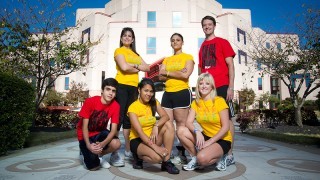
For childhood cancer survivors, the battle isn’t over just because they’ve grown up and the cancer’s gone. Life after cancer can involve years of follow-up care. Side effects and the chance of recurrence are possibilities even after a patient receives a designation that she is “cancer free.”
“It’s always good to be healthy,” explained Tayde, 36 years old, a three-time leukemia survivor and former patient of St. Jude Children’s Research Hospital. “Any time something is not right, it kind of scares you because of your past. It motivates you to keep exercising and be in good health.”
Beloved late founder of St. Jude, Danny Thomas, dreamed that no child should die in the dawn of life. A fundraising team of survivors, aptly named Danny’s Dream Team, was formed in 2010 by bone cancer survivor and St. Jude patient, Gabby, 27 years old. Each year since then, a small group of St. Jude survivors raises funds and participates in events during the St. Jude Memphis Marathon Weekend as St. Jude Heroes.
While achieving their primary objective to give back to St. Jude and raise awareness of its lifesaving mission, Danny’s Dream Team brings members fundraising accountability, increased fitness and camaraderie. “I want to help the kids of St. Jude like somebody helped me when I was a patient,” said Tayde.
“The Dream Team is a simple way to take care of that gift St. Jude gave us, and to give back to the hospital,” said Joel, 35 years old, also a bone cancer survivor. Joel has expanded his reach as a St. Jude Hero to other events outside of the Memphis area, including the South Beach Triathlon and a Warrior Dash event.
Danny’s Dream Team raised $11,800 for St. Jude during 2015, which reflects fundraising successes of previous years. “The funds we raise through the Heroes program will help fund the research that one day will lead to a cure,” said Gabby. “As former patients, to be able to contribute in this way gives us purpose and hope.”
Treatments invented at St. Jude have helped push the overall childhood cancer survival rate from 20 percent to 80 percent since it opened 50 years ago. We won’t stop until no child dies from cancer.
And the members of Danny’s Dream Team are living proof of increased survival rates. “St. Jude is everything to me,” concluded Joel. “It gave me life, which has led to amazing friendships and experiences over the last 28 years since I began treatment.”
Tayde agreed wholeheartedly with his sentiment. “St. Jude is like a little piece of heaven on earth, where miracles happen every day,” she said.
The post A Dream Team appeared first on Competitor.com.
January 21, 2016
New York Road Runners Sued Over NYC Marathon Lottery
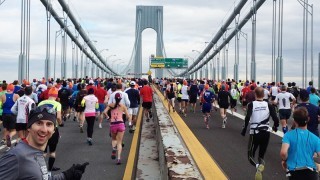
Photo: Brian Metzler
According to Reuters, two runners have filed a proposed class-action lawsuit against the New York Road Runners, alleging that the $11 nonrefundable fee to enter the New York City Marathon’s non-guaranteed lottery is a violation of the New York state constitution.
The suit, filed by Utah residents Charles Konopa and Matthew Clark, seeks $10.56 million in damages, or twice the amount collected from 2010-15 from the drawing. The plantiffs claim that the state constitution was violated because only the state itself can run lotteries based on chance.
The not-for-profit New York Road Runners noticeably do not use the term “lottery” when promoting the non-guaranteed avenue to entry, instead calling it a “drawing.” All applicants pay a non-refundable $11 fee; if their name is drawn they pay the full entry fee ($216 for NYRR members, $255 for U.S. residents and $347 for international residents) to secure a bib. Last year, 80,080 runners entered, and only 18 percent of them secured a bib for the 2015 marathon.
NYRR spokesman Chris Weiller told Reuters that the $11 fee is charged to everyone who registers, even those who are guaranteed entry.
“Our entry process for the marathon is compliant with the law,” he told Reuters.
The lawsuit was filed in U.S. District Court on the same day that the 2016 application process opened up for the marathon.
The news comes less than a year after World Triathlon Corporation’s lottery for entry into the Ironman World Championship in Kona was ruled illegal. Ironman, a for-profit company that puts on long-distance triathlons, was forced to pay $2.7 million to the federal government for money collected in the lottery dating back to 2012. Before the ruling, triathletes entering the Kona lottery had to pay a non-refundable $50 fee, then those selected paid an additional $850 to register for the race. The Kona drawing was especially tough—only 100 were selected out of more than 7,000 entries.
MORE: Reuters
The post New York Road Runners Sued Over NYC Marathon Lottery appeared first on Competitor.com.
Shoe Of The Week: Under Armour SpeedForm Gemini 2
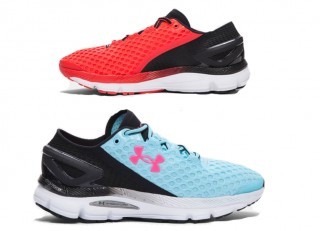
The SpeedForm Gemini 2 is a neutral-oriented high-mileage trainer with a responsive vibe.
Under Armour has shown plenty of signs that it wants to be a dominant player in running and continues to make huge strides in its development of running shoes. After starting with some “barely there” minimalist models, it has expanded slightly to include a few high-mileage trainers with more structure and cushion underfoot. The Gemini 2 is its flagship distance trainer and, although it offers more cushioning and support, it maintains a mostly seamless upper (it’s constructed with ultrasonic welded seams and interior tape for next-to-skin support and comfort) and an external heel counter that provides a snugged-down fit at the rearfoot and midfoot but an ever-so-slightly wider fit in the forefoot.
The best aspect of this shoe, as with the first edition, is the energetic sensation served up by the two-layer foam package. That’s accomplished by the top layer of Charged foam which absorbs impact and, working with the bottom layer of MicroG cushioning, serves up a moderately cushioned and very responsive ride. Our testers believed it felt more like a cushioned shoe at slower speeds and a more energetic shoe at faster speeds on tempo runs and speed workouts. It’s a versatile shoe that offers great proprioceptive feel for the ground, just enough cushioning and a significant amount of energetic pop in every stride. The SpeedForm Gemini 2 Record Equipped version of this shoe ($150) has a tracking chip embedded in the midsole of the left shoe and can record run data automatically, either in real-time on a smartphone or untethered for viewing later at UA’s MapMyRun app.
This is the shoe for you if … you’re seeking slightly “less” shoe that lends toward a natural stride (as opposed to an overly cushioned or structured shoe)
Price: $130
Weights: 10.4 oz. (men’s size 9); 9 oz. (women’s size 7)
Heel-toe-Offsets: 8mm; 35mm (heel); 27mm (forefoot)
RELATED: Shoe Of The Week—Hoka One One Vanquish 2
The post Shoe Of The Week: Under Armour SpeedForm Gemini 2 appeared first on Competitor.com.
Serena Burla: A Top Contender at the U.S. Olympic Trials Marathon
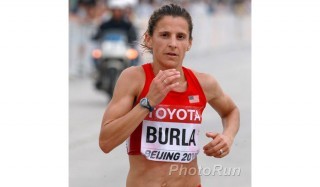
In the past few years, Serena Burla has maintained a low profile. However, her 2:28:01 marathon PR is the fifth fastest U.S. Olympic Trials qualifying time and her most recent 10th place finish at the IAAF World Championships in Beijing was a reminder to not count out the tenacious 33-year-old athlete, mother and cancer survivor on making this year’s U.S. Olympic marathon team.
But flying “under-the-radar” hasn’t bothered Burla much. In fact, it’s only benefitted her running career and made it easier to concentrate on splitting her time between quietly logging miles with her longtime coach Isaya Okwiya and a group of pro runners in the greater Washington, D.C., area, and raising her young son, Boyd.
“Being a professional runner is a 24-hour, seven-days-a-week job,” Burla, a Mizuno-sponsored athlete, says of juggling her running goals with the demands of parenting. “I think many working and runner mothers would agree with me that I always wish I had more time and energy, but the reality is, I do the best I can.”
Her outlook on parenting is similar to her approach on preparing for the Trials on Feb. 13 in Los Angeles.
“Honestly, I’m one of those people that leaves all the logistics up to my coach,” she says. “I just wake up, read my training plan and do what I need to do. You have to focus one day at a time.”
This precise focus on the present moment is what gives Burla a mental edge over the competition. It’s also a wisdom she gained after discovering she had cancer in 2010, which resulted in an intensive procedure removing both the tumor and dominant muscle in her right hamstring.
“Being a cancer survivor has made me very grateful for the opportunity to still be able to run,” she says. “It really encourages you to live for each day and to be a positive role model and put forward your best self on each individual day.”
RELATED: The Favorite: Interview with Shalane Flanagan
Although her recovery was arduous and uncertain—her coach Okwiya was worried if the compensation would strain other muscles—she made a quick eight-month post-surgery comeback by running a 2:37:06 and placing fourth among American women at the New York City Marathon. That put her in the mix for the 2012 U.S. Olympic Trials in Houston.
However, her nerves got in the way that year. Unable to eat the night before race day, she collapsed from lack of carbohydrate fuel and hypoglycemia after mile 18, and had to drop out of the race early.
Despite the disappointing performance in Houston, though, other races since then have proven that Burla’s running momentum is on the upswing. She placed third at the 2012 Seoul International Marathon and achieved her first sub-2:30 PR of 2:28:27. The following year in Amsterdam she placed second and beat her previous marathon PR by 26 seconds (the time that would qualify her for this year’s Olympic Trials), and had ran the fastest women’s marathon time on a record-eligible course that year. Then in 2014 she returned to the USA Half Marathon Championships, dominating the field and winning her first national championships in 1:10:48.
“I have the most respect for the marathon,” she says, reflecting on the progress she’s made since her surgery and bouncing back from a bad Olympic Trials Marathon debut. “You race for different reasons, sometimes for place, sometimes for time, and those races where I ran 2:28, I got in a great race where I was racing the competition, but also had my own race plans and splits to zone in on.”
RELATED: Desi Linden Talks About Her Pre-Olympic Trials Training
This year Burla plans on executing the entire Olympic Trials Marathon course and giving it everything she has, no matter where that puts her.
“What will be on that day will be,” she says. ” Anything can happen in the last eight miles of a marathon. You kind of just hold your breath until you cross the finish line.”
RELATED: 2016 U.S. Olympic Trials By The Numbers
The post Serena Burla: A Top Contender at the U.S. Olympic Trials Marathon appeared first on Competitor.com.
Out There: No Meddling Needed

Last year, my little sister, Meghan, ran her first half marathon.
It was one of the hardest things I’ve ever done.
You see, I am a Very Helpful Person. If you ask me for advice, I’ll happily give it to you. If you don’t ask me for advice, I’ll happily give it to you anyway, because that’s what Very Helpful People do.
This is especially true when it comes to Meghan. In my role as big sister, I feel the need to set the ropes, remove all obstacles, and light the way for my favorite person in the whole world. Naturally, when she said she wanted to train for her first half marathon, I immediately went into Very Helpful Person mode:
“You should sign up for the half I’m doing this winter, and then I can pace you! What’s your expected pace, anyway? Have you been doing tempo workouts? I’m going to send you some exercises to do for cross-training, and you should –“
“Actually,” Meghan interrupted, “I already know the race I’m doing, and I’ve got my training plan set up. I’ve been working with a trainer once a week for strength work, too.”
“Oh!” I exclaimed. “E-mail me the details. I’ll take a look at it all, make sure it’s solid.”
“Nah, I’m good.”
And with that, Meghan went off to blaze her own trail. Meanwhile, I stood there, stunned. Didn’t she see the path I had already set for her? How could she turn down the aid of an experienced runner like me? Didn’t she know I was a Very Helpful Person, dammit?
“Maybe you don’t need to meddle in this one, dear,” said my husband, Neil, as I voiced my outrage. “It sounds like she’s got it figured out.”
“Meddle?” I scoffed. “I don’t meddle. I help.”
“You meddle.”
“What if she screws up? She needs me.”
Neil shrugged. “What if she doesn’t?”
Determined to prove everyone wrong, I sat back and waited for Meghan to self-destruct. Surely, she’d realize she needed my aid soon. I harbored fantasies of the day she would grovel at my feet, admitting she should have called upon my seniority in life and in running.
One day, my phone buzzed with a text from Meghan:
I just did my longest run ever! Seven miles!
The next week, she gushed over her 8-mile accomplishment; the following week, 9. Though my reply was always joyful, I worried she was increasing her mileage too quickly. Was she staying on top of her strength training? Was she running hills? Had she practiced her nutrition yet? Was she scheduling rest days?
Do you need anything from me? I always asked.
Nah, I’m good, Meghan always replied. She didn’t bite the Very Helpful bait I was dangling, and it drove me crazy. I had no choice but to simply share in her joy and silently wait for her to encounter a situation she couldn’t handle. Eventually, she’d need her older, wiser, more proficient big sister, right?
As it turns out—yes, she did eventually need me: On race day, for a big hug at the finish line. Not only did Meghan finish her first half marathon, but she did so faster than she had anticipated.
Over post-race brunch, my little sister—now donning a shiny new finisher’s medal—looked…different. Stronger. More confident. Like someone who didn’t need her big sister’s help anymore.
“I can’t believe I did that!” Meghan laughed.
“You did that—and spectacularly so, I might add.” I replied.
“Thanks for being here.”
“I wouldn’t have missed it for the world.”
“And thanks for not meddling when I would talk about my training.”
“I don’t meddle. I help.”
“You meddle.”
We both laughed. Meghan adjusted the medal hanging around her neck—the one she had earned all by herself.
“Hey, Meg?”
“Yeah?”
“I’m really proud of you.”
Meghan smiled and extended her arms wide for a hug.
“I couldn’t have done it without you.”
***
About The Author:
Susan Lacke does 5Ks, Ironman Triathlons and everything in between to justify her love for cupcakes (yes, she eats that many). Susan lives and trains in Salt Lake City, Utah with three animals: A labrador, a cattle dog, and a freakishly tall triathlete husband. She claims to be of sound mind, though this has yet to be substantiated by a medical expert. Follow her on Twitter: @SusanLacke.
The post Out There: No Meddling Needed appeared first on Competitor.com.
Ryan Hall's Blog
- Ryan Hall's profile
- 21 followers



